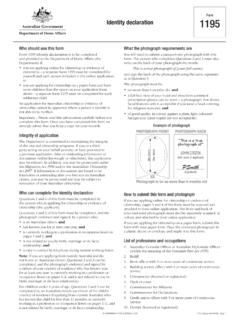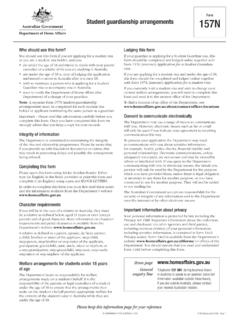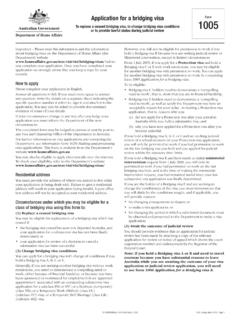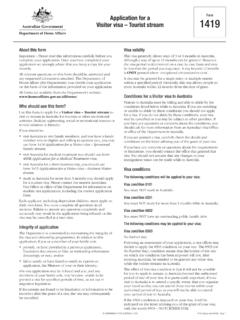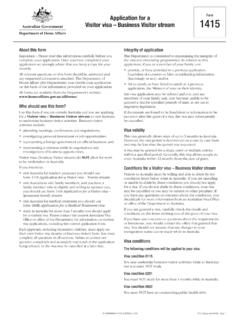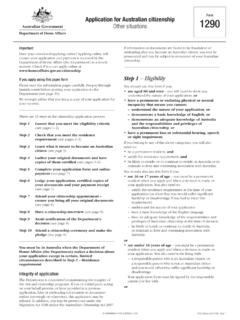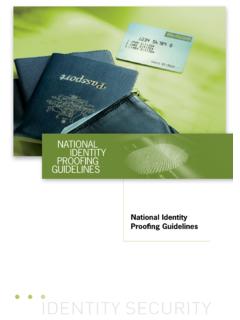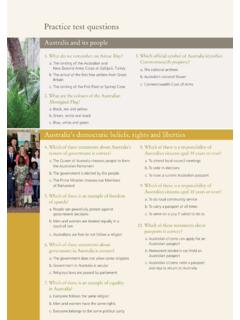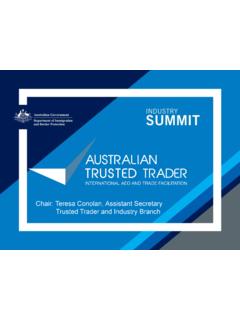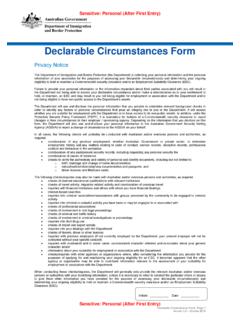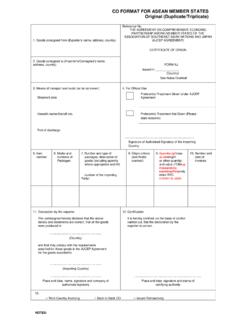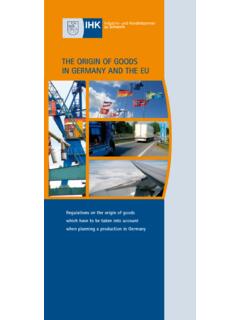Transcription of Integrated Cargo System – claiming preferential …
1 Integrated Cargo System claiming preferential tariff rates To claim preferential tariff rates under the Integrated Cargo System ( ICS) you should follow the steps set out below: 1. Refer to Schedule 3 to the Customs Tariff (the Tariff) to identify the tariff classification and the general tariff rate that applies to those goods. 2. To identify the preferential tariff rate that applies under a trade arrangement, refer to Schedule 3, 4, 5, 6, 7, 8, 9, 10, 11 or 12 depending on the country of origin, to the Tariff. To establish whether goods from an external territory are of a kind eligible for duty-free entry, refer to the relevant Commonwealth enactment that applies to that territory. 3. If the preferential tariff rate for the good is less than the general tariff rate, refer to the rules of origin for the relevant trade arrangement set out in Divisions 1A to 1L of the Customs Act or in the SPARTECA (TCF Provisions) Scheme.
2 4. Establish that the goods meet the rules of origin for the relevant trade arrangement. 5. Once you have established that the goods meet the rules of origin for the relevant trade arrangement, you must complete, at a minimum, the following fields in the Origin/Preference box on the Tariff Line Information Screen of the import declaration: Origin Country the two-digit Country Code for the country of origin determined for non- preferential purposes (eg trade statistics)1. Most Country Codes reflect the corresponding United Nations (UN) International Standard Organization (ISO) codes. All Country Codes can be found by selecting the icon next to the Origin Country field on the import declaration. Preference Origin Country the two-digit Country Code for the relevant country or territory in which the goods originate for preferential tariff purposes.
3 Only one Preference Country Code can be specified for each tariff line. If a Preference Origin Country is not input, it will default to the first Origin Country input. All Country Codes can be found by selecting the icon next to the Preference Origin Country field on the import declaration. The ICS Country Codes for Least Developed Countries, Forum Island countries and various classes of Developing Countries can also be found in Schedule 1 to the Tariff. Preference Scheme the relevant abbreviation for the trade arrangement that applies to the goods. Most of these abbreviations reflect the abbreviations used in the Tariff. A complete list is at Part 1 of the Attachment to this document. 1 The ICS allows up to ten Country Codes to be specified in the Origin Country fields. This facility should be used where different goods must be classified together within a single tariff classification (eg sets of goods put up for retail sale).
4 The origin of the good that determines the tariff classification should be input first. The multiple Origin Country facility should not be used to input goods of different origins falling within the same classification onto a single tariff line. These goods must be input on separate tariff lines. Preference Rule (nature 10, nature 30 and nature 10 lines of nature 10/20 import declarations only) the relevant abbreviation for the rule of origin that applies to the goods. A complete list is at Part 2 of the Attachment to this document. A matrix showing the Preference Rules that apply to each Preference Scheme is at Part 3 of the Attachment. The legislative provision(s) for each Preference Scheme/Preference Rule combination is set out in Part 4 of the Attachment. The relevant Preference Rule abbreviation appears on Certificates of Origin (COO) issued in accordance with Australia s Free Trade Agreement s (FTA) with Thailand, Singapore, Chile, Korea, Malaysia, and New Zealand and the ASEAN Member States under the ASEAN-Australia-New Zealand Free Trade Agreement (AANZFTA) and on the COO or origin certification document in accordance with Australia s Economic Partnership Agreement (EPA) with Japan.
5 6. If one of the special Preference Rules listed below is input on the import declaration (natures 10, 10/20 and 30 only), ensure that the following additional requirements or conditions associated with that rule are met: Preference Rule P25 or P30B a Tariff Concession Order (TCO) must be input in the Preference Instrument Type and Preference Instrument Number fields of the Additional Tariff Line Information Screen. Preference Rule A30B a Tariff Concession Order (TCO) must be input in the Preference Instrument Type and Preference Instrument Number fields of the Additional Tariff Line Information Screen; and tariff classification restrictions apply, as set out in ACN 2003/49 and in the relevant ICS Preference Rule Reference File. Preference Rule P40 the Local Content % field on the Additional Tariff Line Information Screen must be completed; the Preference Origin Country must be WS ; the goods must be classified within ; and the goods must be entered for home consumption on or before 22 October 2010.
6 Preference Rule TCF the ELAC Number field on the Additional Tariff Line Information Screen must be completed; Treatment Code 731 must be input on the Tariff Line Information Screen; and tariff classification restrictions apply, as set out in the SPARTECA (TCF Provisions) Scheme (administered by the Department of Industry) and in the relevant ICS Preference Rule Reference File. Preference Rule A30A , A50 or P30A tariff classification restrictions apply, as set out in ACN 2003/49 and in the relevant ICS Preference Rule Reference Files. 7. Provided Steps 5 and 6 are completed, customs duty should be calculated in accordance with the preferential tariff rate. 8. If appropriate evidence that the goods meet the rules of origin for preferential tariff purposes cannot be found, or if the preferential tariff rate is the same as the general tariff rate for the goods, preference details should not be input on the import declaration.
7 Only the Origin Country field in the Origin/Preference box on the Tariff Line Information Screen of the import declaration must be completed. Duty will be calculated in accordance with the general tariff rate. Frequently asked questions Q1. What is a preferential tariff rate? Australia has a number of trade arrangements with other countries. Under those arrangements, Australia may have agreed to provide some or all goods that originate in those countries and places with rates of customs duty that are lower than those that apply to imports from other countries. Those lower rates are called preferential tariff rates. The tariff rates that apply to other countries are called general tariff rates. For the purposes of ICS import declarations, the SPARTECA (TCF Provisions) Scheme and the duty-free provisions for certain goods that originate in Norfolk, Christmas and Cocos (Keeling) Islands (external territories) will be treated as trade arrangements.
8 Q2. When can I claim a preferential tariff rate? A preferential tariff rate can be claimed only where that rate is less than the general tariff rate that would otherwise apply to the goods. Q3. Where can I find general and preferential tariff rates? General tariff rates, and some preferential tariff rates (such as for developing countries), are set out against the tariff classifications found in Schedule 3 to the Customs Tariff Act 1995 (the Tariff). preferential tariff rates that apply under Australia s FTA with the United States can be found in Schedule 5 to the Tariff. preferential tariff rates that apply under Australia s FTA with Thailand can be found in Schedule 6 to the Tariff. preferential tariff rates that apply under Australia s FTA with Chile can be found in Schedule 7 to the Tariff. preferential tariff rates that apply under AANZFTA can be found in Schedule 8 to the Tariff. Schedule 9 sets out the excise equivalent rates of duty in relation to goods imported under Australia s bilateral FTA with Malaysia.
9 preferential tariff rates that apply under Australia s FTA with Korea can be found in Schedule 10 to the Tariff. preferential tariff rates that apply under Australia s EPA with Japan can be found in Schedule 11 to the Tariff. preferential tariff rates that apply under Australia s FTA with China can be found in Schedule 12 to the Tariff. General and preferential tariff rates for tariff concessions can be found in Schedule 4 to the Tariff. Goods imported under Australia s bilateral FTAs with New Zealand and Singapore are free of duty. Goods from parties to other FTAs with Australia that are not listed in Schedules 5, 6, 7, 8, 9, 10, 11 or 12 of the Tariff are free of duty. Duty-free entry for certain goods that originate in the external territories is provided through the following Commonwealth enactments that apply to each of those territories, not through the Tariff: Norfolk Island Act 1979 (section 64); Christmas Island Act 1958 (section 21); Cocos (Keeling) Islands Act 1955 (section 18A).
10 Q4. When do goods originate in a country for preferential tariff purposes? Goods originate in a country for preferential tariff purposes if they meet the rules of origin that apply under the relevant trade arrangement. The rules of origin for Australia s trade arrangements are set out in Divisions 1A to 1L of Part VIII of the Customs Act 1901 (the Customs Act). Those rules are explained in more detail in the Instructions and Guidelines for each FTA. Q5. How can I establish that the goods meet the rules of origin for preferential tariff purposes? You must not claim preferential tariffs unless you can establish that the goods meet the relevant rules of origin. Depending on the trade arrangement, you may be able to establish in a variety of ways. For claiming preference under Australia s FTA s with Thailand, Singapore, Chile, New Zealand, Malaysia, Korea or AANZFTA, you can use a COO issued in accordance with that FTA as prima facie evidence that the goods satisfy the rules of origin.
